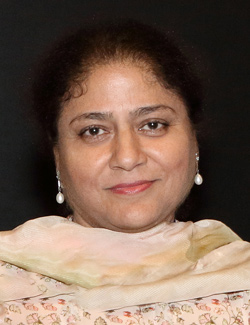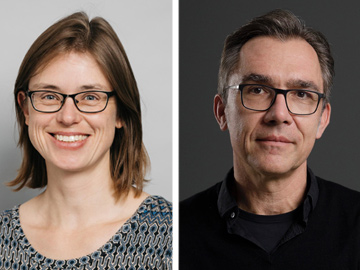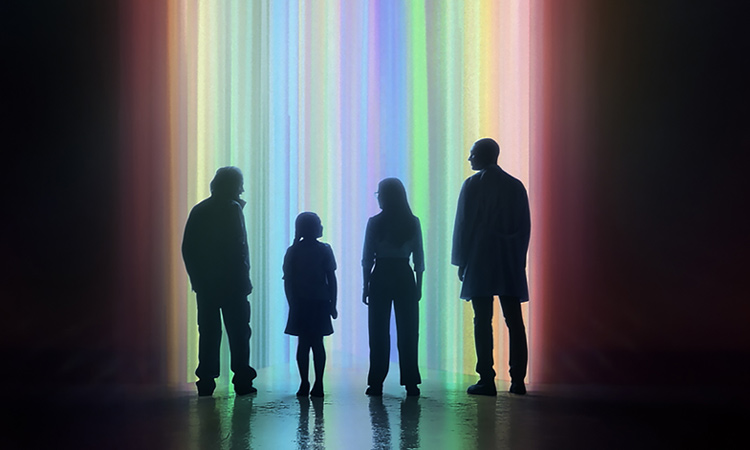 IEEE Photonics Society, OSA and SPIE produced a short video celebrating IDL.
IEEE Photonics Society, OSA and SPIE produced a short video celebrating IDL.
Sixty years ago on 16 May, Theodore Maiman successfully demonstrated the first laser. And since 2018, the light science community has partnered with UNESCO to repurpose that date as the International Day of Light (IDL)—a global observance and annual opportunity to celebrate light and all that it enables, in everything from science to sustainable development and education.
During its first two years, celebrations of IDL were conspicuously social and community-oriented affairs, organized at a local and grassroots level alongside a grander flagship event. These events brought scientists, educators and light enthusiasts together to learn about light’s contributions to our society and how light-based technologies can help to address global challenges.
Following the 2019 celebration, organizers determined that, rather than being put into a flagship event, resources should go toward a virtual campaign that would provide an anchor to the many grassroots events. But 2020 presented additional challenges. In the midst of the pandemic, social distancing and lockdowns to prevent the spread of COVID-19 have forced all manner of events—whether for work, school or outreach—to be canceled or modified to conform to society’s new normal.
In the context of the current global crisis, the planned virtual campaign was more relevant than ever, so the organizers of the 2020 celebration kicked their plans into digital high gear. As many communities converted celebrations to virtual formats, #SEETHELIGHT took shape as a message that the future beyond the pandemic would be bright because of the science of light.
Building community
To build buzz and start a conversation with the public before 16 May, the team behind #SEETHELIGHT, which was managed in part by OSA and sponsored by the IEEE Photonics Society, OSA and SPIE, produced and shared a 90-second video that spotlighted four major areas where light-based solutions play a key role—driving the world toward cleaner energy, food security, high-speed connectivity and better medical treatments and diagnostics. The video, which debuted at the CLEO Technical Conference, was shared widely on social media, reaching thousands of screens to impart the message of light appreciation.
As a complement to that video presentation, four essays written by luminaries in various areas of optics and photonics were published on the same four topics. The essays convey how light-based solutions are advancing energy, agriculture, telecom and medicine today, even during the pandemic—and how they can continue to do so in the future. To give OPN’s readers a flavor of the messages that these optical scientists carried to the public, we’ve published excerpts from each of these articles in the following pages.
Through descriptions of past innovations and recent research, the contributing authors illustrate the state of the art in each of these four fields—defining the role that light plays in achieving UNESCO’s sustainable-development goals to feed, power, connect, treat and generally better our society. They also discuss paths toward a more sustainable future, and how cutting-edge research in light science is part of that journey.
“The general public may not ever remember that 16 May was chosen because of Maiman demonstrating the laser,” says OSA Foundation development director John Taylor. “But we hope one day that the world will remember that we celebrate IDL because the science of light and light-based technologies have changed—and continue to change—our lives for the better.”
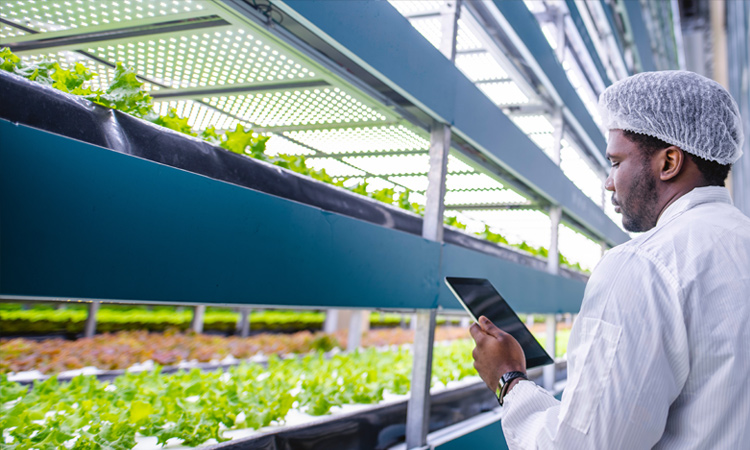 [Getty Images]
[Getty Images]
“The applications of photonics in agriculture is a small window into the amazing capabilities of light and its ability to solve humanity’s problems.”
—OSA Member Cather Simpson, University of Auckland, New Zealand
Sustainable Farming
OSA Member Cather Simpson University of Auckland, New Zealand
The food-assistance branch of the United Nations, the World Food Programme, recently warned of a forthcoming “hunger pandemic.” While 821 million people already go to bed hungry every night, an additional 265 million could be pushed to the brink of starvation due to COVID-19 by the end of 2020.
Indoor farming
So how can photonics and laser-based technologies help our farmers? For one, light-emitting diodes (LEDs) have become an integral part of indoor farming, which has the potential to increase our ability to feed the world sustainably. Indoor or vertical farming is the practice of growing plants in vertically stacked layers inside of an enclosed, controlled environment. Farms can produce the same amount of food in a much smaller footprint.
The cost of indoor farming has dropped significantly over the last 10 to 15 years, partially due to the availability of cheaper, more efficient LED lighting. LEDs can also be tuned to the precise colors that crops will best absorb. Adjusting the “light recipe” for each type of plant can improve productivity or enhance desirable traits. For instance, adding a period of supplemental red LED light may increase the antioxidant content of some vegetables. LED lighting also can serve as the major source of tunable light for crop gardening in urban buildings and even in outer space.
Precision agriculture
The use of technology to increase crop yields while lowering the levels of inputs like land, water and fertilizer has been dubbed “precision agriculture.” Light-based technologies have contributed in the form of optical sensors that allow farmers to better understand variation in soils, plants, insects, disease and other factors. These sensors can be handheld, attach to farm equipment, or even work remotely from drones and satellites. For example, some farmers equip drones with cameras that capture near-infrared light. By measuring the type of light that gets reflected or absorbed, these sensors can differentiate a healthy plant from a sick plant.
Light-based technologies also play a role in quickly measuring the physical characteristics of plants—which is important for plant breeding. Researchers at the University of California, Davis, USA, developed a robot that uses rapid, non-destructive sensing technology to measure plant features in the field. The device uses multiple optical sensors to create a 3D reconstruction of a single plant, from which a set of physical characteristics like number of leaves, plant height, and leaf size can later be extracted by a computer algorithm.
Where’s the beef?
Sex-sorting of sperm is important to the productivity of dairy and beef industries worldwide. Dairy farms want mostly female-only sperm for obvious reasons, while beef farms want mostly male-only sperm to raise cows that will produce more meat.
My team started working on a device that could nondestructively sort sperm by sex with microfluidics and laser light. The DNA content of the sperm cells is stained with a dye before being injected into the microfluidic chip. It turns out that the X chromosome is a little bit bigger than the Y chromosome, which means that female cells have more DNA content than male cells—in optics terms, the females glow a bit “brighter” than the males.
Once the sperm cells enter the chip, a laser is used to make the dye glow. Then, a light sensor detects how brightly the cell glows to determine whether it is male or female. Right before the channel forks off, another laser nudges the male cells towards one branch and the female cells towards the other.
The applications of photonics in agriculture is a small window into the amazing capabilities of light and its boundless ability to solve humanity’s problems. It can be harnessed as an energy source, a sensor, and a tool to increase food production and the sustainability of farming.
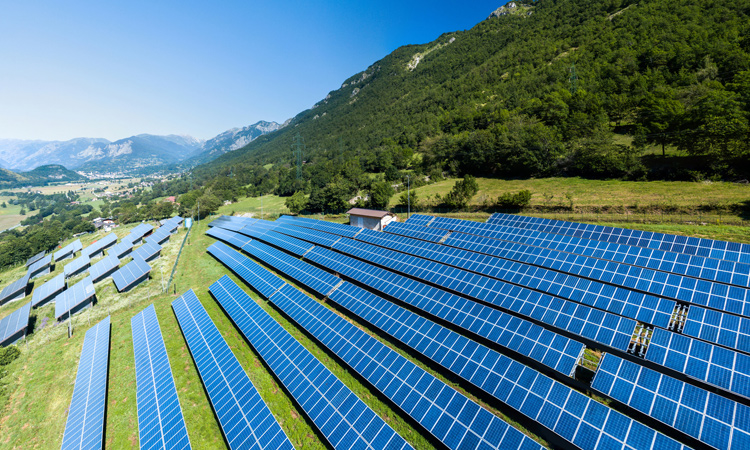 [Getty Images]
[Getty Images]
University of Waterloo“The growing use of LED bulbs is having a distinct, positive effect on greenhouse gas emissions.”
—2013 OSA President and OSA Fellow Donna Strickland, University of Waterloo, Canada
Cleaner Energy
2013 OSA President and OSA Fellow Donna Strickland University of Waterloo, Canada
A lack of reliable energy services means health clinics and schools can’t function properly, clean water and sanitation become harder to come by and agricultural productivity suffers. It has lasting repercussions for just about every area of life. In addition, energy poverty often goes hand in hand with pollution.
On the bright side, access to electricity is gradually expanding throughout the world with the help of light-based technologies. Off-grid solar power provides a renewable, clean energy source for rural communities, serving as a cheaper and environmentally friendly alternative to diesel generators. LEDs have boosted the energy efficiency of light bulbs and could save developing countries US$40 billion a year. We also use photonic sensing technologies to detect the signatures of light to measure the impact of fossil fuels—and their lower-carbon-emitting counterparts—on the environment.
Solar accessibility
Solar energy has always been clean, climate-friendly and renewable. But the piece of puzzle that went missing for decades—affordability—has finally fallen into place. Since 2010, the cost of converting sunlight into electricity has dropped by 80%. Today, solar is cheaper than natural gas or coal in many parts of the world.
For those living in energy poverty, solar solutions represent a lower-cost, environmentally friendly alternative to the diesel generators many people currently use. According to the World Bank, more than 700,000 off-grid solar systems have been installed in Sub-Saharan Africa, and last year, it committed over $200 million to solar projects in the same region. The world’s largest countries are also jumping on board. China has built giant solar farms and, as a result, boasts more solar energy capacity than any country in the world.
“Green” LEDs
Compared to incandescent bulbs and fluorescent tubes, LED lighting reduces electricity usage, materials consumption and costs. Data shows that the growing use of LED bulbs is having a distinct, positive effect on greenhouse gas emissions.
In 2017 alone, LED lighting in buildings and outdoor spaces reduced carbon dioxide emissions by an estimated 570 million tons—roughly the equivalent of shutting down 162 coal-fired power plants. One-sixth of the world’s population uses fuel-based lighting, spending 100- to 1000-times per unit of illumination than those with electricity access. LEDs, in combination with off-grid solar systems, have the power to free these individuals from lighting poverty. Many in Africa, Asia and Latin America have already initiated the changeover.
Environmental monitoring
Environmental monitoring of our waters, soils, and atmosphere is essential to realizing the full impact of humankind’s actions, whether they be positive or negative. Light-based technologies can measure air and water quality, biomass, carbon emissions, atmospheric chemistry, and much more.
For instance, satellites that orbit the Earth remotely detect greenhouse gas emissions via optical spectroscopy. Since every gas absorbs light at different wavelengths, the abundance of carbon dioxide and methane in a given location can be calculated from these measurements.
Lidar is a remote sensing technology being used by NASA to measure the thickness of sea ice via the satellite ICESat-2. Another NASA satellite tracked the massive vertical migration of small sea creatures—which has a huge effect on Earth’s climate—with lidar.
Other examples of light-based technologies for environmental sensing abound. Scientists are using jets equipped with imaging spectrometers over Australia’s Great Barrier Reef to assess the health of its corals, photonics technologies to monitor ecosystem changes in the Canadian North, and lasers to track carbon flow in coastal redwood forests of California.
Light contains infinite possibilities for science and technologies that can transform our world. And the positive impact of these changes on the environment can even be measured using light.
 [Getty Images]
[Getty Images]
Roberto Barnaba, ICTP Photo Archives“Investment in optical-fiber infrastructure and the science of light will improve access to high-speed connectivity for all nations.”
—OSA Senior Member Imrana Ashraf, Quaid-i-Azam University, Pakistan
High-Speed Connectivity
OSA Senior Member Imrana Ashraf Quaid-i-Azam University, Pakistan
Even though we think of light as visual, it increasingly transmits the sound of the human voice. Over the last half-century, scientists have discovered how to make thin and incredibly pure glass fibers. They’ve also discovered how to transmit light through them—fiber optics. Because of this technology, the world has become connected together with optical network cables that transmit vast volumes of information around the planet.
The connectivity gap
But what about the nations like my own Pakistan that are often called, economically speaking, “developing nations”? Are we participating in the worldwide connectivity revolution of the last few decades? Although developing nations vary widely due to wealth, population distribution, topography and geographic isolation, they are racing to catch up and bridge the digital gap. However, it’s times like our current situation, when we are weathering a pandemic, that the digital gap for high-speed connectivity seems especially wide, particularly with regards to education.
As many of us are now experiencing globally, high-speed connectivity can greatly increase access to everything—including education. Many education programs are “going virtual.” Many developing countries, including Pakistan, have made great strides toward the high-speed communications infrastructure needed for remote learning, but there are still many hurdles exacerbated by our current crisis, including a lack of internet-accessible devices, sufficient infrastructure and affordable access.
Light, education and hope
Light-based technologies have also revolutionized the displays and computer systems needed to access the internet. From sophisticated manufacturing processes that etch tiny circuitry into silicon wafers to make computer chips, to the LED pixels that light up smartphone display screens, todays’ devices are smaller, cheaper and more powerful because of the science of light and light-based technologies.
In addition to enabling the internet and user access to it, there are solutions to powering the telecommunications network. All of the devices connected to the internet run on electricity—which sunlight can provide. Photovoltaic solar-panel farms generate safe, clean, renewable electricity to power the telecom infrastructure. Pakistan gets about 7% of its electricity needs from renewable sources, and renewable electricity is an area where both the developed and developing nations are expected to grow.
Solid-state indoor lighting with LED lamps is another light-based technology that can help people study safely at night. As the cost of solar panels goes down and LED lighting becomes commonplace, remote communities where the cost of delivering electricity is high may see an alternative of solar-panel farms to power their lights, computers and other devices—all enabled by innovation in the light-based technology.
A more accessible future
As we look back at the amazing invention of optical fiber and its enabling impact on all of these tools, apps and devices we rely on, it’s fun to imagine what might be next. For example, Li-Fi is a relatively new type of visible-light communication that encodes data signals in the beam from a LED light. Other light-based technologies such as optical sensors and miniaturized cameras will connect to form not just “Internet of Things” homes, but smart neighborhoods and even smart cities.
A future where all can benefit from these new technologies depends on access. Investment in optical-fiber infrastructure and the science of light will improve access to high-speed connectivity for all nations.
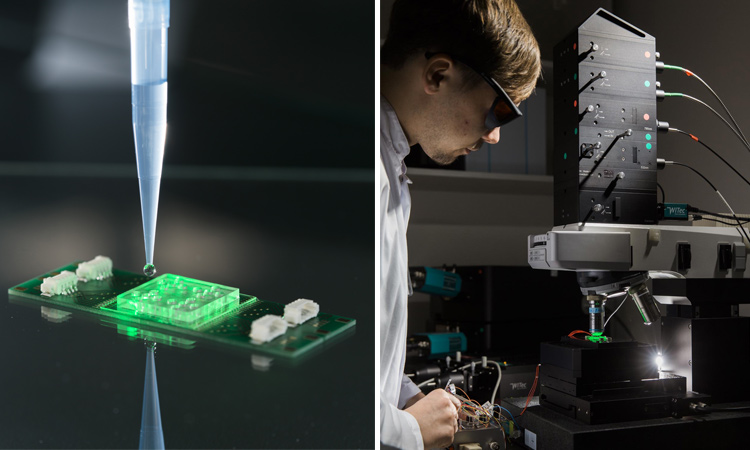 [Sven Doering/Leibniz-IPHT]
[Sven Doering/Leibniz-IPHT]
“Many light-based approaches are simpler to use, with less sample preparation involved.”
—Ute Neugebauer and OSA Senior Member Jeurgen Popp, Leibniz Institute of Photonic Technology e.V. Jena, Germany
Better Diagnostics and Treatments
Ute Neugebauer and OSA Senior Member Jeurgen Popp, Leibniz Institute of Photonic Technology e.V. Jena, Germany
As COVID-19 continues to spread around the world, we have become witness to the devastating, all-encompassing impact of infectious disease. A pandemic also exacerbates inequalities in healthcare, public services, and education. Poor populations in countries without universal healthcare could be priced out of access to testing, treatment and vaccines.
Researchers worldwide are frantically working on solutions, and light-based technologies have joined the fight. Tried-and-true diagnostic techniques like optical microscopy employ light to test for the presence of microorganisms in a patient’s sample. And our own labs at the Leibniz Institute of Photonic Technology in Jena, Germany, are investigating next-generation imaging and spectroscopic methods that use laser light to identify pathogens and their resistance to medications to optimize how patients are treated.
Disease fingerprinting
If a laser is shined on a sample, the way some of the light scatters back depends on the molecules contained within it and how they vibrate in response to the light. Different molecules will scatter in different ways, effectively creating a molecular “fingerprint.” Together with deep-learning algorithms, we can use this molecular fingerprint information to identify bacteria on a single-cell level.
The power of this light-based approach is that, first of all, it really speeds up the diagnostic process. We have used our device to analyze bacteria such as E. coli from samples of patients’ urine, with the entire procedure taking only an hour. Standard microbiological methods for urine testing typically take at least 24 hours. Instead of waiting a whole day or more, the results can be received—and more importantly, acted on—much faster with our technique.
In addition, we have the ability to give more information about a person’s disease for the purpose of individualized treatment. For example, vibrational spectroscopy in combination with microscopy can determine whether bacteria are resistant to a particular drug by observing their interaction. If bacteria are still multiplying in the presence of an antibiotic, we know they have developed resistance to it. The test only takes 90 to 120 minutes, and with that data, a physician can then optimize treatment for a patient without wasting precious time on ineffective or broad-spectrum drugs.
Vibrational spectroscopy can also be used to determine the source of an infection, not only by hunting for the pathogen itself, but also from observing changes in the patient’s white blood cells. With only a few drops of blood, this method can recognize the molecular fingerprint of a white blood cell that has encountered a certain pathogen and provide an accurate diagnosis.
Lastly, many light-based approaches have the advantage of being simpler to use with less sample preparation involved. Vibrational spectroscopy, for instance, does not use any stains, dyes, or markers to highlight the microorganism. The lack of extra chemicals speeds up the process and allows live cells to be measured in their natural state. Researchers who develop new drugs or perform basic research on pathogens may benefit from measurement techniques that will not interfere with the normal function of cells.
COVID-19 and personalizing medicine
While vibrational spectroscopy remains an experimental technique, we hope to make a commercially available device for the clinic within the next five years. The device would characterize bacteria and perform fast antibiotic-resistance testing. Right now, the lab is busy working on new diagnostic approaches to the COVID-19 crisis.
In the field of infectious disease—a topic that is very much in focus in our current COVID-19 world—light-based technologies have already made an enormous impact with optical microscopy and PCR testing. The next five to ten years could see new techniques start to take hold that optimize the accuracy, cost and speed of diagnostics. And with better diagnostics comes better treatment, including a greater push towards personalized medicine.
These articles were originally published for the International Day of Light #SEETHELIGHT Campaign. #SEETHELIGHT is a worldwide message encouraging all to join the conversation and celebrate the importance of the science of light and light-based technologies in our lives. Learn more at www.lightday.org/seethelight.



